transmission YAMAHA YZ85 2015 Owners Manual
[x] Cancel search | Manufacturer: YAMAHA, Model Year: 2015, Model line: YZ85, Model: YAMAHA YZ85 2015Pages: 88, PDF Size: 2.07 MB
Page 9 of 88

TABLE OF CONTENTS
LOCATION OF IMPORTANT
LABELS..............................................1-1
SAFETY INFORMATION ...................2-1
DESCRIPTION ...................................3-1
Left view ..........................................3-1
Right view ........................................3-2
Controls and instruments ................3-3
INSTRUMENT AND CONTROL
FUNCTIONS .......................................4-1
Handlebar switch ............................4-1
Clutch lever .....................................4-1
Shift pedal .......................................4-2
Brake lever ......................................4-2
Brake pedal .....................................4-3
Fuel tank cap ...................................4-3
Fuel ..................................................4-3
Fuel tank breather hose...................4-5
Fuel cock .........................................4-6
Starter (choke) knob ........................4-6
Kickstarter .......................................4-7
Seat .................................................4-7
Adjusting the front fork ....................4-8
Front fork bleeding ..........................4-9
Adjusting the shock absorber assembly ....................................4-10
Removable sidestand ....................4-12 FOR YOUR SAFETY –
PRE-OPERATION CHECKS
............. 5-1
OPERATION AND IMPORTANT
RIDING POINTS ................................ 6-1
Starting and warming up a cold engine .......................................... 6-1
Starting a warm engine................... 6-1
Shifting............................................ 6-2
Engine break-in............................... 6-3
Parking ............................................ 6-4
PERIODIC MAINTENANCE AND
ADJUSTMENT .................................. 7-1
Periodic maintenance and lubrication chart .......................... 7-2
Checking the spark plug................. 7-8
Transmission oil .............................. 7-9
Coolant ......................................... 7-10
Cleaning the air filter element ....... 7-12
Adjusting the carburetor ............... 7-14
Adjusting the engine idling speed......................................... 7-14
Adjusting the throttle grip free play ............................................ 7-15
Tires .............................................. 7-15
Spoke wheels ............................... 7-17
Adjusting the clutch lever free play ............................................ 7-18
Checking the brake lever free play ............................................ 7-19 Checking the shift pedal ............... 7-19
Checking the front and rear brake
pads ........................................... 7-20
Checking the brake fluid level ....... 7-20
Changing the brake fluid ............... 7-22
Drive chain slack ........................... 7-22
Cleaning and lubricating the drive chain .......................................... 7-23
Checking and lubricating the cables ........................................ 7-24
Checking and lubricating the
throttle grip and cable ............... 7-24
Checking and lubricating the brake and clutch levers ............. 7-24
Checking and lubricating the brake pedal ................................ 7-25
Lubricating the rear suspension.... 7-25
Lubricating the swingarm pivots ... 7-26
Checking the front fork ................. 7-26
Checking the steering ................... 7-27
Checking the wheel bearings ........ 7-27
Supporting the motorcycle ........... 7-28
Front wheel ................................... 7-28
Rear wheel .................................... 7-29
Troubleshooting ............................ 7-31
Troubleshooting charts ................. 7-32
MOTORCYCLE CARE AND
STORAGE .......................................... 8-1
Matte color caution ......................... 8-1
Care................................................. 8-1
U1SN83E0.book Page 1 Monday, September 8, 2014 2:36 PM
Page 21 of 88

SAFETY INFORMATION
2-2
2
Many accidents involve inexperi-
enced operators.
• Make sure that you are qualified and that you only lend your mo-
torcycle to other qualified oper-
ators.
• Know your skills and limits. Staying within your limits may
help you to avoid an accident.
• We recommend that you prac- tice riding your motorcycle until
you have become thoroughly
familiar with the motorcycle and
all of its controls.
Many accidents have been
caused by error of the motorcycle
operator. A typical error made by
the operator is veering wide on a
turn due to excessive speed or un-
dercornering (insufficient lean an-
gle for the speed). Never travel
faster than warranted by condi-
tions.
Ride cautiously in unfamiliar ar-
eas. You may encounter hidden
obstacles that could cause an ac-
cident.
The posture of the operator is im-
portant for proper control. The op-
erator should keep both hands on
the handlebar and both feet on the
operator footrests during opera-
tion to maintain control of the mo-
torcycle.
Never ride under the influence of
alcohol or other drugs.
Be sure the transmission is in neu-
tral before starting the engine.
Protective Apparel
The majority of fatalities from motorcy-
cle accidents are the result of head in-
juries. The use of a safety helmet is the
single most critical factor in the pre-
vention or reduction of head injuries. Always wear an approved helmet.
Wear a face shield or goggles.
Wind in your unprotected eyes
could contribute to an impairment
of vision that could delay seeing a
hazard.
The use of a jacket, heavy boots,
trousers, gloves, etc., is effective
in preventing or reducing abra-
sions or lacerations.
Never wear loose-fitting clothes,
otherwise they could catch on the
control levers, footrests, or wheels
and cause injury or an accident.
Always wear protective clothing
that covers your legs, ankles, and
feet. The engine or exhaust sys-
tem become very hot during or af-
ter operation and can cause
burns.
Avoi d Car bon Monoxi de Poisonin g
All engine exhaust contains carbon
monoxide, a deadly gas. Breathing
carbon monoxide can cause head-
aches, dizziness, drowsiness, nausea,
confusion, and eventually death.
Carbon Monoxide is a colorless, odor-
less, tasteless gas which may be pres-
ent even if you do not see or smell any
engine exhaust. Deadly levels of car-
bon monoxide can collect rapidly and
you can quickly be overcome and un-
able to save yourself. Also, deadly lev-
els of carbon monoxide can linger for
hours or days in enclosed or poorly
ventilated areas. If you experience any
symptoms of carbon monoxide poi-
U1SN83E0.book Page 2 Monday, September 8, 2014 2:36 PM
Page 23 of 88

SAFETY INFORMATION
2-4
2
operator and may limit control
ability, therefore, such accesso-
ries are not recommended.
Use caution when adding electri-
cal accessories. If electrical ac-
cessories exceed the capacity of
the motorcycle’s electrical sys-
tem, an electric failure could re-
sult, which could cause a
dangerous loss of lights or engine
power.
Aftermarket Tires an d Rims
The tires and rims that came with your
motorcycle were designed to match
the performance capabilities and to
provide the best combination of han-
dling, braking, and comfort. Other
tires, rims, sizes, and combinations
may not be appropriate. Refer to page
7-15 for tire specifications and more in-
formation on replacing your tires.
Transportin g the Motorcycle
Be sure to observe following instruc-
tions before transporting the motorcy-
cle in another vehicle. Remove all loose items from the
motorcycle.
Check that the fuel cock (if
equipped) is in the “OFF” position
and that there are no fuel leaks.
Point the front wheel straight
ahead on the trailer or in the truck
bed, and choke it in a rail to pre-
vent movement.
Shift the transmission in gear (for
models with a manual transmis-
sion).
Secure the motorcycle with tie-
downs or suitable straps that are
attached to solid parts of the mo-
torcycle, such as the frame or up-
per front fork triple clamp (and not,
for example, to rubber-mounted
handlebars or turn signals, or
parts that could break). Choose
the location for the straps carefully
so the straps will not rub against
painted surfaces during transport.
The suspension should be com-
pressed somewhat by the tie-
downs, if possible, so that the mo-
torcycle will not bounce exces-
sively during transport.
U1SN83E0.book Page 4 Monday, September 8, 2014 2:36 PM
Page 25 of 88

DESCRIPTION
3-2
3
EAU10421
Right view
1
9
81011
6
7
5
2 3,4
1. Shock absorber assembly compression damping force adjusting
screw (page 4-10)
2. Kickstarter (page 4-7)
3. Front fork rebound damping force adjusting screw (page 4-8)
4. Bleed screw (page 4-9)
5. Front fork compression damping force adjusting screw (page 4-8)
6. Spark plug cap (page 7-8)
7. Transmission oil filler cap (page 7-9)
8. Coolant drain bolt (page 7-11) 9. Brake pedal (page 4-3)
10.Transmission oil drain bolt (page 7-9)
11.Shock absorber assembly rebound damping force adjusting screw
(page 4-10)
U1SN83E0.book Page 2 Monday, September 8, 2014 2:36 PM
Page 28 of 88
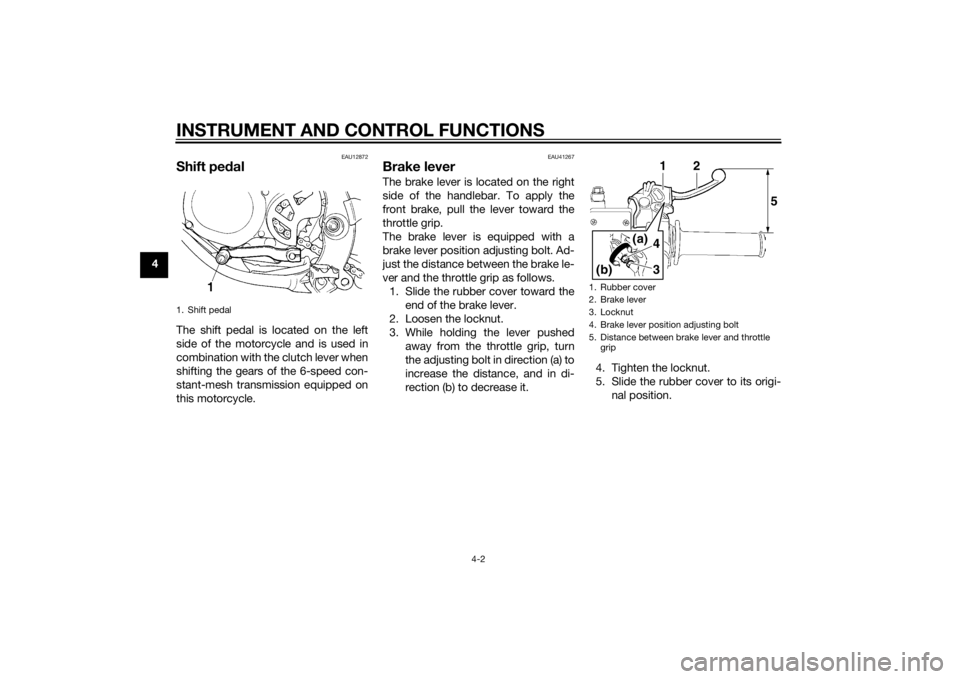
INSTRUMENT AND CONTROL FUNCTIONS
4-2
4
EAU12872
Shift pedalThe shift pedal is located on the left
side of the motorcycle and is used in
combination with the clutch lever when
shifting the gears of the 6-speed con-
stant-mesh transmission equipped on
this motorcycle.
EAU41267
Brake leverThe brake lever is located on the right
side of the handlebar. To apply the
front brake, pull the lever toward the
throttle grip.
The brake lever is equipped with a
brake lever position adjusting bolt. Ad-
just the distance between the brake le-
ver and the throttle grip as follows.
1. Slide the rubber cover toward the end of the brake lever.
2. Loosen the locknut.
3. While holding the lever pushed away from the throttle grip, turn
the adjusting bolt in direction (a) to
increase the distance, and in di-
rection (b) to decrease it. 4. Tighten the locknut.
5. Slide the rubber cover to its origi-
nal position.
1. Shift pedal
1. Rubber cover
2. Brake lever
3. Locknut
4. Brake lever position adjusting bolt
5. Distance between brake lever and throttle grip
143
(a)
(b)
2
5
U1SN83E0.book Page 2 Monday, September 8, 2014 2:36 PM
Page 33 of 88
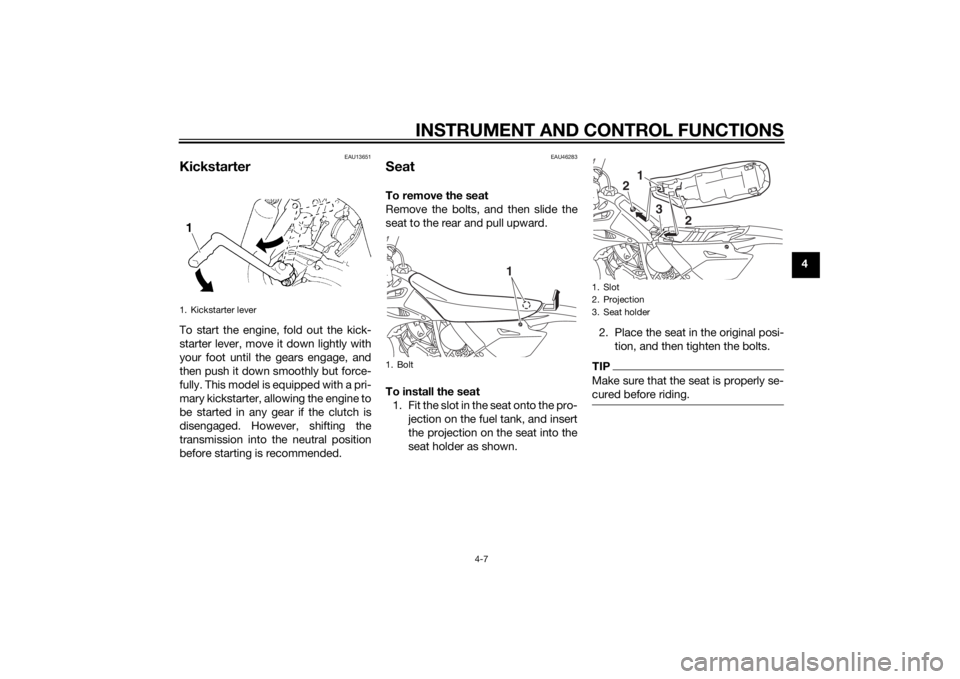
INSTRUMENT AND CONTROL FUNCTIONS
4-7
4
EAU13651
KickstarterTo start the engine, fold out the kick-
starter lever, move it down lightly with
your foot until the gears engage, and
then push it down smoothly but force-
fully. This model is equipped with a pri-
mary kickstarter, allowing the engine to
be started in any gear if the clutch is
disengaged. However, shifting the
transmission into the neutral position
before starting is recommended.
EAU46283
SeatTo remove the seat
Remove the bolts, and then slide the
seat to the rear and pull upward.
To install the seat1. Fit the slot in the seat onto the pro- jection on the fuel tank, and insert
the projection on the seat into the
seat holder as shown. 2. Place the seat in the original posi-
tion, and then tighten the bolts.
TIPMake sure that the seat is properly se-
cured before riding.
1. Kickstarter lever
1. Bolt
1
1. Slot
2. Projection
3. Seat holder
1
2
3
2
U1SN83E0.book Page 7 Monday, September 8, 2014 2:36 PM
Page 39 of 88
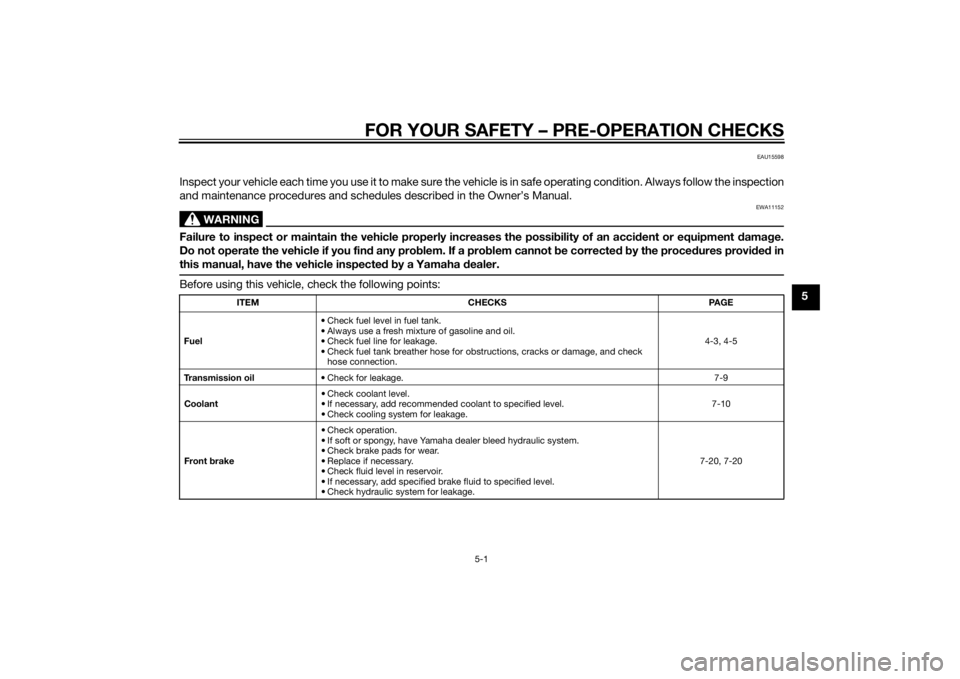
FOR YOUR SAFETY – PRE-OPERATION CHECKS
5-1
5
EAU15598
Inspect your vehicle each time you use it to make sure the vehicle is in safe operating condition. Always follow the inspection
and maintenance procedures and schedules described in the Owner’s Manual.
WARNING
EWA11152
Failure to inspect or maintain the vehicle properly increases the possibility of an acci dent or equipment damag e.
Do not operate the vehicle if you fin d any pro blem. If a pro blem cannot be corrected b y the proce dures provi ded in
this manual, have the vehicle inspecte d b y a Yamaha dealer.Before using this vehicle, check the following points:
ITEM CHECKS PAGE
Fuel • Check fuel level in fuel tank.
• Always use a fresh mixture of gasoline and oil.
• Check fuel line for leakage.
• Check fuel tank breather hose for obstructions, cracks or damage, and check
hose connection. 4-3, 4-5
Transmission oil • Check for leakage. 7-9
Coolant • Check coolant level.
• If necessary, add recommended coolant to specified level.
• Check cooling system for leakage. 7-10
Front brake • Check operation.
• If soft or spongy, have Yamaha dealer bleed hydraulic system.
• Check brake pads for wear.
• Replace if necessary.
• Check fluid level in reservoir.
• If necessary, add specified brake fluid to specified level.
• Check hydraulic system for leakage. 7-20, 7-20
U1SN83E0.book Page 1 Monday, September 8, 2014 2:36 PM
Page 42 of 88

OPERATION AND IMPORTANT RIDING POINTS
6-1
6
EAU15952
Read the Owner’s Manual carefully to
become familiar with all controls. If
there is a control or function you do not
understand, ask your Yamaha dealer.
WARNING
EWA10272
Failure to familiarize yourself with
the controls can lead to loss of con-
trol, which coul d cause an acci dent
or injury.
EAU41308
Startin g an d warmin g up a
col d en gine1. Turn the fuel cock lever to “ON”.
2. Shift the transmission into the
neutral position.
3. Turn the starter (choke) on and completely close the throttle. (See
page 4-6.)
4. Start the engine by pushing the kickstarter lever down.
5. When the engine is warm, turn the starter (choke) off.TIPThe engine is warm when it responds
quickly to the throttle with the starter
(choke) turned off.NOTICE
ECA11043
For maximum en gine life, never ac-
celerate har d when the en gine is
col d!
EAU16661
Startin g a warm en gineFollow the same procedure as for
starting a cold engine with the excep-
tion that the starter (choke) is not re-
quired when the engine is warm.
Instead, start the engine with the throt-
tle slightly open.TIPIf the engine does not start after sever-
al kicks, try again with the throttle 1/4
to 1/2 open.
U1SN83E0.book Page 1 Monday, September 8, 2014 2:36 PM
Page 43 of 88
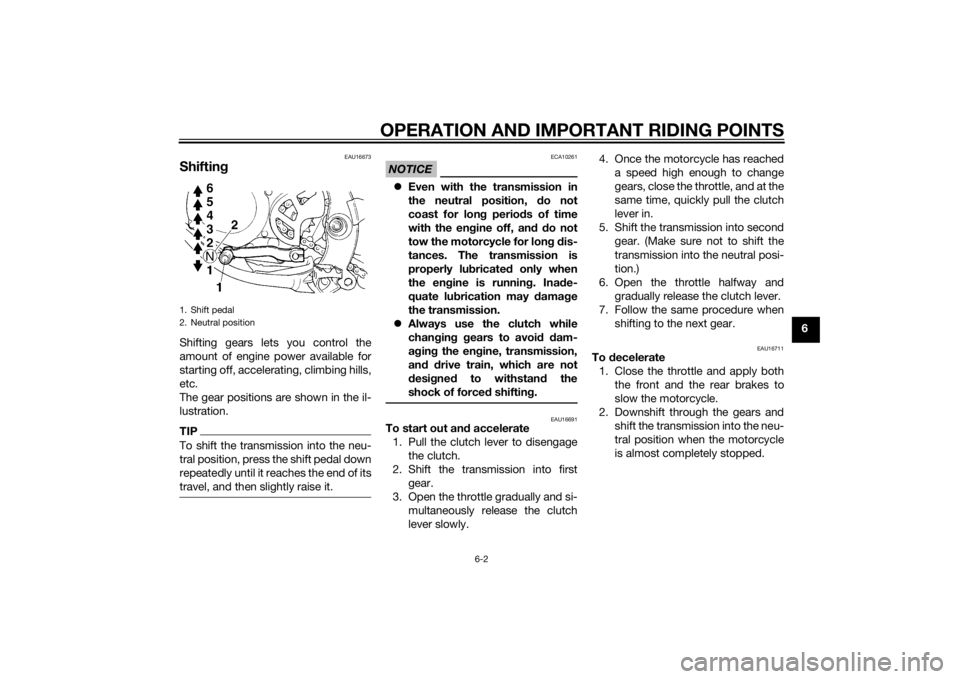
OPERATION AND IMPORTANT RIDING POINTS
6-2
6
EAU16673
ShiftingShifting gears lets you control the
amount of engine power available for
starting off, accelerating, climbing hills,
etc.
The gear positions are shown in the il-
lustration.TIPTo shift the transmission into the neu-
tral position, press the shift pedal down
repeatedly until it reaches the end of its
travel, and then slightly raise it.
NOTICE
ECA10261
Even with the transmission in
the neutral position, do not
coast for lon g period s of time
with the eng ine off, and d o not
tow the motorcycle for lon g d is-
tances. The transmission is
properly lu bricated only when
the en gine is runnin g. Ina de-
quate lu brication may damag e
the transmission.
Always use the clutch while
chan gin g g ears to avoi d d am-
a g in g the en gine, transmission,
an d d rive train, which are not
d esi gne d to withstan d the
shock of forced shifting.
EAU16691
To start out an d accelerate
1. Pull the clutch lever to disengage the clutch.
2. Shift the transmission into first gear.
3. Open the throttle gradually and si- multaneously release the clutch
lever slowly. 4. Once the motorcycle has reached
a speed high enough to change
gears, close the throttle, and at the
same time, quickly pull the clutch
lever in.
5. Shift the transmission into second gear. (Make sure not to shift the
transmission into the neutral posi-
tion.)
6. Open the throttle halfway and gradually release the clutch lever.
7. Follow the same procedure when shifting to the next gear.
EAU16711
To decelerate
1. Close the throttle and apply both the front and the rear brakes to
slow the motorcycle.
2. Downshift through the gears and shift the transmission into the neu-
tral position when the motorcycle
is almost completely stopped.
1. Shift pedal
2. Neutral position
U1SN83E0.book Page 2 Monday, September 8, 2014 2:36 PM
Page 44 of 88
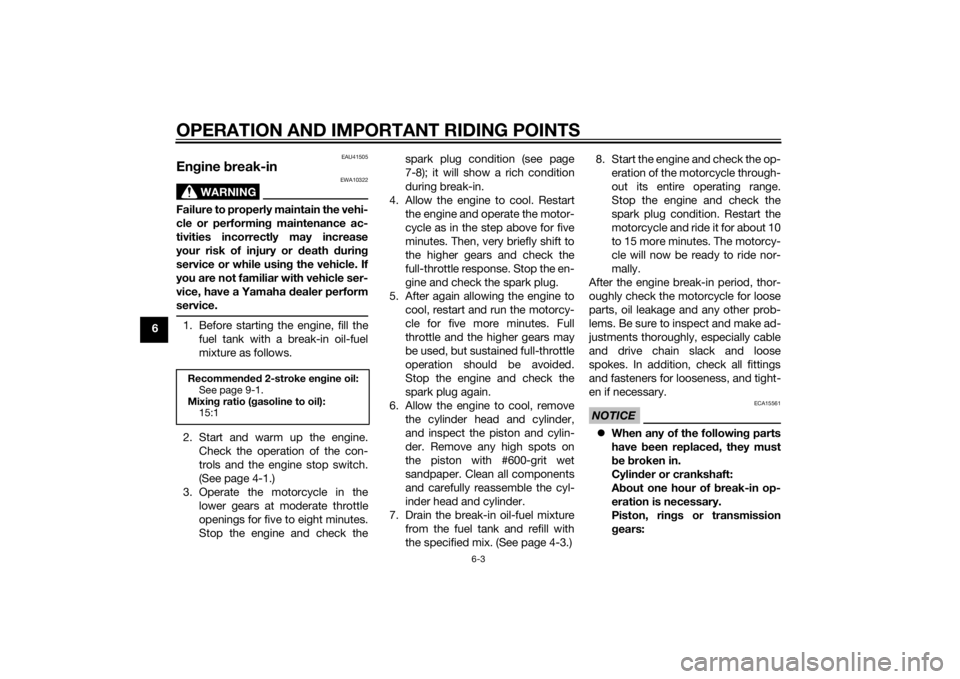
OPERATION AND IMPORTANT RIDING POINTS
6-3
6
EAU41505
Engine break-in
WARNING
EWA10322
Failure to properly maintain the vehi-
cle or performin g maintenance ac-
tivities incorrectly may increase
your risk of injury or death durin g
service or while usin g the vehicle. If
you are not familiar with vehicle ser-
vice, have a Yamaha d ealer perform
service.1. Before starting the engine, fill the fuel tank with a break-in oil-fuel
mixture as follows.
2. Start and warm up the engine. Check the operation of the con-
trols and the engine stop switch.
(See page 4-1.)
3. Operate the motorcycle in the lower gears at moderate throttle
openings for five to eight minutes.
Stop the engine and check the spark plug condition (see page
7-8); it will show a rich condition
during break-in.
4. Allow the engine to cool. Restart the engine and operate the motor-
cycle as in the step above for five
minutes. Then, very briefly shift to
the higher gears and check the
full-throttle response. Stop the en-
gine and check the spark plug.
5. After again allowing the engine to cool, restart and run the motorcy-
cle for five more minutes. Full
throttle and the higher gears may
be used, but sustained full-throttle
operation should be avoided.
Stop the engine and check the
spark plug again.
6. Allow the engine to cool, remove the cylinder head and cylinder,
and inspect the piston and cylin-
der. Remove any high spots on
the piston with #600-grit wet
sandpaper. Clean all components
and carefully reassemble the cyl-
inder head and cylinder.
7. Drain the break-in oil-fuel mixture from the fuel tank and refill with
the specified mix. (See page 4-3.) 8. Start the engine and check the op-
eration of the motorcycle through-
out its entire operating range.
Stop the engine and check the
spark plug condition. Restart the
motorcycle and ride it for about 10
to 15 more minutes. The motorcy-
cle will now be ready to ride nor-
mally.
After the engine break-in period, thor-
oughly check the motorcycle for loose
parts, oil leakage and any other prob-
lems. Be sure to inspect and make ad-
justments thoroughly, especially cable
and drive chain slack and loose
spokes. In addition, check all fittings
and fasteners for looseness, and tight-
en if necessary.
NOTICE
ECA15561
When any of the followin g parts
have been replaced , they must
b e broken in.
Cylin der or crankshaft:
A bout one hour of b reak-in op-
eration is necessary.
Piston, rin gs or transmission
g ears:
Recommen ded 2-stroke en gine oil:
See page 9-1.
Mixin g ratio ( gasoline to oil):
15:1
U1SN83E0.book Page 3 Monday, September 8, 2014 2:36 PM